-
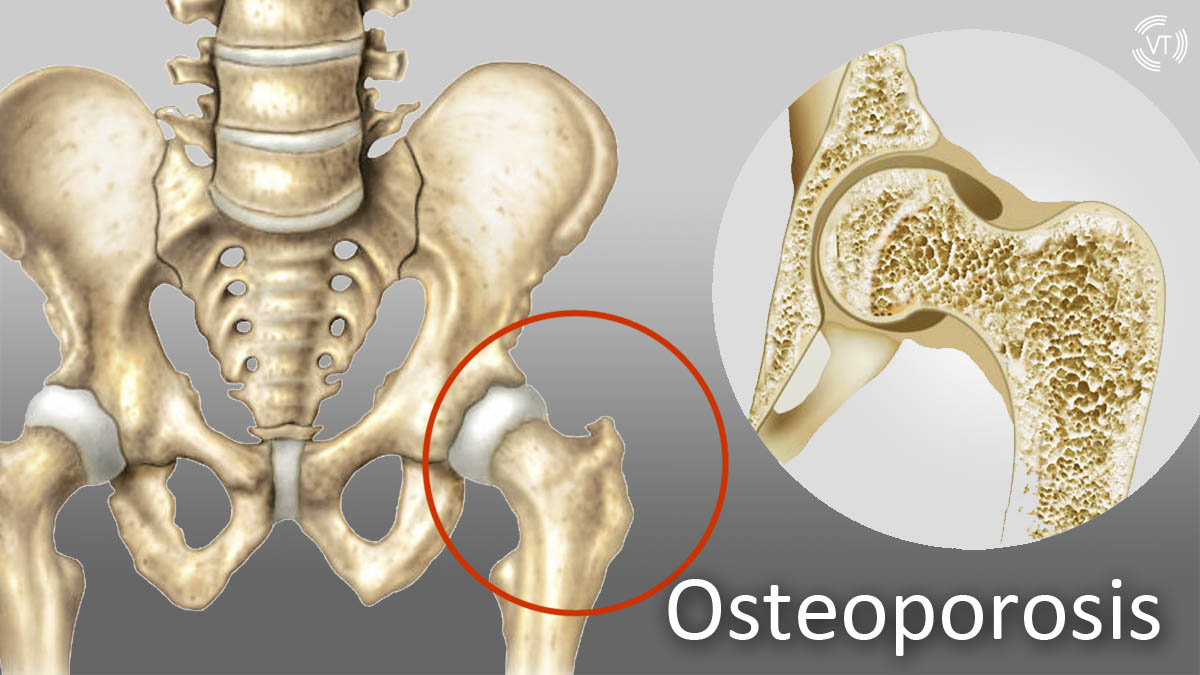
- Vibration Therapy for Osteoporosis
- Vibration G-force's Impact on Human Body
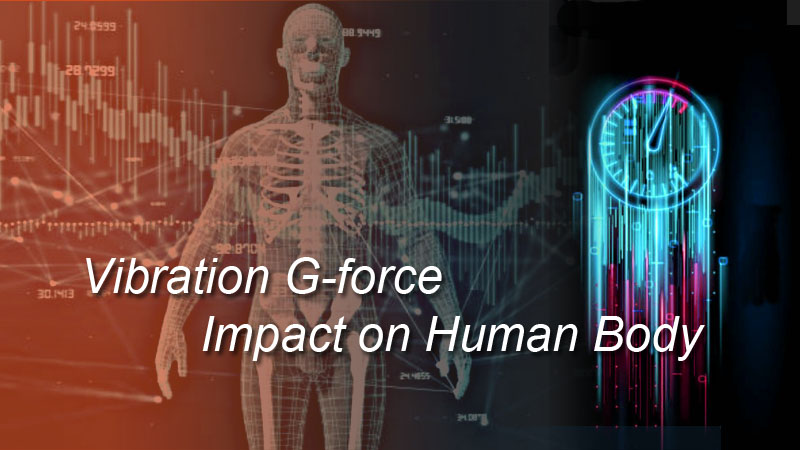
- Vibration G-force's Impact on Human Body
- How Does Vibration Therapy Work?
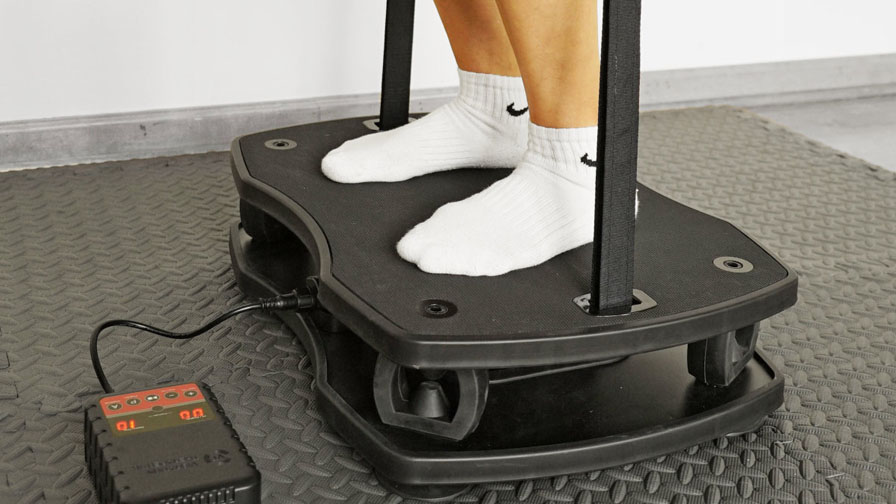
- How Does Vibration Therapy Work?
-
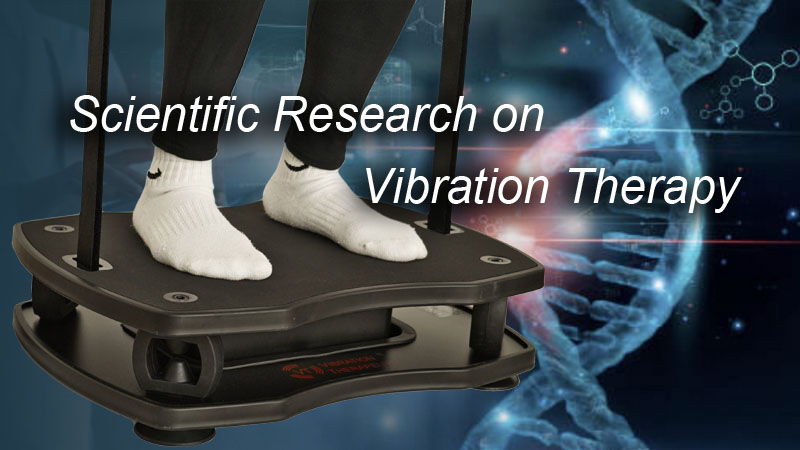
- Scientific Research on Vibration Therapy
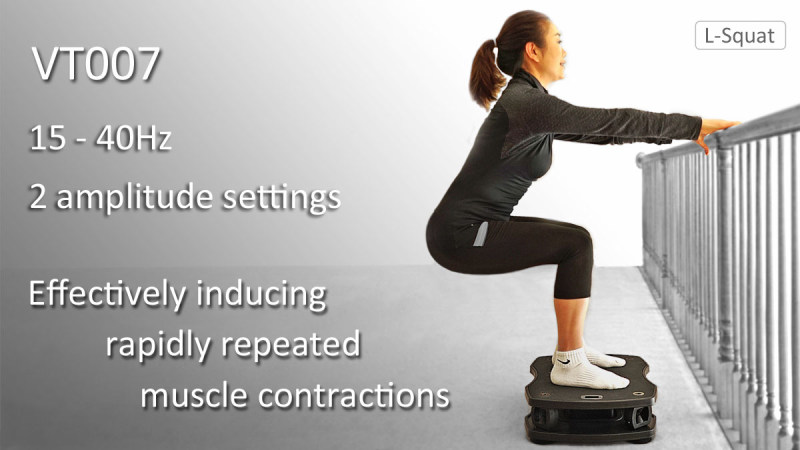
I have been asked by customers, from time to time, if my VT007 can provide 0.4 G. These questions often refer to Dr. Clinton Rubin’s Marodyne vibration plate and his YouTube videos about using his device for osteoporosis treatment.
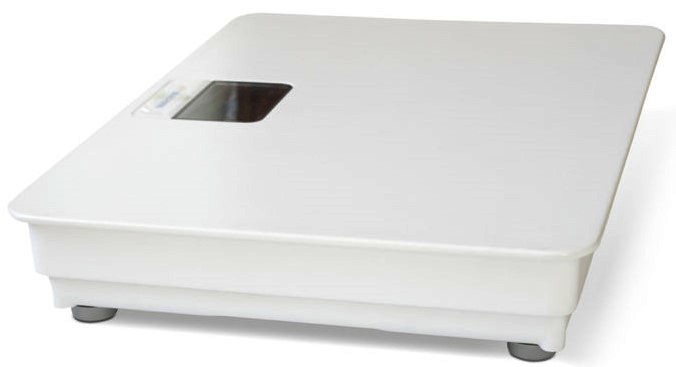
Marodyne LiV Vibration Plate
Dr. Clinton Rubin represents a vibration plate model named Marodyne LiV. He promotes Marodyne LiV for treating osteoporosis, claiming that using his low-intensity vibration plate is effortless — users simply stand straight and relax on his Marodyne for 10 minutes a day, and it can increase their bone density.
Isn't that too easy?
However, I understand his audience tend to believe in things that promise results with minimal effort.
Anyway, decided to look deeper into Dr. Robin's ideas and his Marodyne LiV.
The Marodyne vibration plate has been around for over 10 years. Dr. Rubin is very active in social media marketing, and the Marodyne brand has built up a strong online presence associated with osteoporosis treatment. Dr. Rubin is highly influential, with a large audiences attracted to his low-intensity vibration therapy concept and the Marodyne LiV vibration plate.
Many people are now wondering weather my VT007 vibration plate is a low-cost alternative to the Marodyne LiV.
Well, the two models are very different.
In this article, I compare the tech specs of Marodyne LiV and VT007 and add my comments about the logics behind these two models.
I seriously question Dr. Rubin's low-intensity vibration therapy concept and the effectiveness of his Marodyne LiV vibration plate.
Marodyne vibration plate is designed with a fixed frequency of 30Hz. Its amplitude is recently disclosed on their website as fluctuating between 50 and 200 micron. In one of Dr. Rubin's previous YouTube videos, he stated the amplitude of Marodyne LiV as 125 micron.
50 - 200 micron (0.05-0.2 mm) is just about paper thickness. A regular printing paper is about 100 micron thick.
In other words, Marodyne moves up and down about a paper‑thin distance. It vibrates like "buzz", as Dr. Rubin described.
For VT007, I provide transparent product information on my website, including not only the motion pattern, frequency, amplitude, and G‑force, but also the structure, mechanics and the materials.
In a short summary, VT007 is a linear vibration plate model that employs an eccentric‑wheel device to generate vibration. VT007 has an amplitude range from 0.7mm to 2.6mm (two amplitude settings), and an adjustable frequency range from 15Hz to 40Hz.
| Tech Specs Comparison between Marodyne and VT007 | ||
|---|---|---|
| Marodyne LiV | VT007 | |
| Product Photo |

|
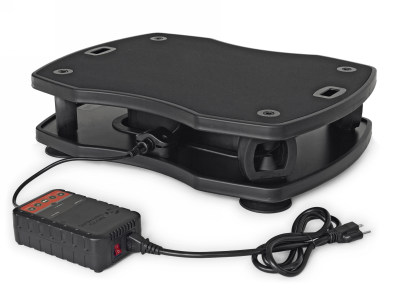 |
| Frequency | 30Hz | Two Settings 15 - 40Hz |
| Amplitude | Fluctuating 0.05-0.2mm |
Adjustable Low: 0.7-1.2mm High: 1.5-2.6mm |
| G-Force | Fluctuating 0.06-0.23 0.4 claimed by Rubin |
Adjustable @NoLoad: 0.25-3.65 @180Lb: 0.16-3.02 |
| Movement device | Not disclosed | Eccentric wheel + spring |
| Motor Rated Power | 70W | DC Motor 80W |
| Max Load | Not specified | 250 lb |
| Machine Weight | 18Lb | 24 Lb |
| Dimensions | 17"x14"x3" | 22"x16"x5.7" |
| Feature | G-force calibration (a fake design?) |
Two amplitude settings |
Marodyne's paper-thin amplitude is almost negligible. Such a tiny displacement does not actually induce additional skeletal muscle contraction.
VT007 has a much higher vibration intensity compared to Marodyne LiV.
Dr. Rubin claims an incorrect G-force for his Marodyne LiV vibration plate.
Vibration G-force is decided by vibration frequency and amplitude. Given a 30Hz frequency and 50‑200 micron amplitude, I calculate out that the G-force of Marodyne LiV is 0.06-0.23G.
The 0.4G acceleration that Dr. Rubin claimed does not correspond with the amplitude and frequency of Marodyne LiV. I challenge Marodyne's engineers about their method of calculating the G-force for their vibration plate.
In physics, the acceleration of vibration movement is analyzed and calculated using Simple Harmonic Model , which is the theoretical base for my G-force calculation.
Amplitude and frequency are the two variables that decide the G-force. Marodyne website provides a fixed frequency and a fluctuating amplitude between 50 and 200 micron. It is contradictory to the fixed 0.4G he recommended, and Marodyne's G-force is not even 0.4G.
To get 0.4G at 30Hz frequency, the amplitude (displacement) needs to be 350 micron.
VT007 has adjustable frequency from 15 to 30Hz and two amplitude settings. To compare with Marodyne at 30Hz frequency, VT007 provides 1.38G on high amplitude setting and 0.88G on low amplitude setting, for a 180Lb user.
Vibration G-force is actually not a constant value. As vibration plate moves up and down, its G-force changes between the max positive value and the max negative value in every motion circle which lasts only a tiny fraction of a second. The G-force defined to indicate the vibration intensity is the G-force of the 4th phase of a vibration cycle. The 4th phase is the only phase that the vibration plate accelerates upwards and actually applies pushing force on the user.
Because the G-force of a vibration plate is in a consecutive short-pulse pattern, our body does not perceive much of the magnitude of acceleration and the pushing force it produces.
Let's use an example to understand the perception of a short-pulse G-force in comparison with a sustained G-force.
[For sustained G-force], let's say you are a 200Lb payroad in a rocket. During the launch, the rocket rises at 2G acceleration which sustains for 3 minutes. During this time, the rocket applies 200Lbx2=400Lb force pushing you up. Adding your own body weight, you would feel as if your body weight is 400+200=600Lb.
You may hear that the rocket-launch G-force is around 3G. That is the G-force that the astronaut gets. This 3G includes the acceleration of gravity (1G). So 2G is about the actual G-force created by the rocket from its velocity change during the launch.
[For short-pulse G-force], now you get off the rocket, go back home and step on a vibration plate with a 2G acceleration running at 30Hz. The vibration plate applies a 400Lb force pushing you up. Adding your own body weight, you would feel a 600Lb pulling-down force. However, on the vibration plate, the upwards acceleration only occurs in 1/4 vibration movement cycle (the 4th phase). One cycle lasts 1/30 second. Therefore your body bear the 600Lb pulling-down force for only 0.008 second (1/120) in each cycle. This is so short a time period that you don't even perceive you have ever experienced the 600Lb pulling-down force, but the mechanical stimulation on your muscles and bones is a real 600Lb.
On a 2G vibration plate running at 30Hz, you experience a pulling-down force about the same magnitude you would get from a rocket launch. It is just that, on the vibration plate, this pulling-down force lasts only 0.008 second, repeating 30 times a second; while on the rocket, it sustains a few minutes.
This explains how vibration acceleration can put higher magnitude mechanical stimulation on your body without you perceiving much of the magnitude.
In summary, vibration plates can provide high magnitude mechanical stimulation without stressing your muscles and bones.
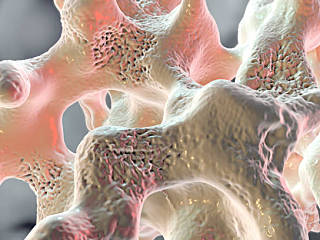
In his YouTube videos, Dr. Rubin discussed how our musculoskeletal system responds to mechanical signal for bone growth, and how the stimulation signal influences stem cell differentiation, turning the stem cells to bone cells other than fat cells, etc.
I have also been developing my own hypothesis based on mechanical stimulation for bone growth, and how vibration can be utilized to serve this role. I understand the attributes and functions of muscles and bones, and their reaction to mechanical stimulation, from physics perspective.
Dr. Rubin did not explain the logic about how he came up with his low-intensity vibration therapy concept. His concept is actually contradictory to well accepted scientific belief.
Mechanical stimulation for bone growth is well recognized and accepted in science society. However Dr. Rubin's low-intensity assertion and his "surrogate" concept may not make a qualified mechanical stimulation for bone growth.
Dr. Rubin is trying to make his reasoning plausible by mixing well-accepted medical science and facts in his talk, but he jumps to his conclusion with mysteries.
For effective bone growth promotion, my studies lead me to conclude that the mechanical stimulation needs to
This is my concept base against Dr. Robin's. I also disagree the stand-straight body pose that Dr. Rubin strongly recommends.
Dr. Rubin asserts that the vibration intensity needed for stimulating bone growth is very low. He comes up with a MAGIC NUMBER - 0.4G.
He did not explain the reason of his low intensity vibration concept except for safety concerns. He kept stress that vibration is a nasty thing as he quoted an ISO adversary about occupation related extended exposure to intensive vibration. However that is not the case, when people usually use their vibration plates for 5 to 20 minutes a day.
Dr. Rubin is strongly against using a 10G vibration plate, like a Galileo model. Okay, perhaps 10G is too high, but how did he come up with his magic 0.4G. What if 1.4G is also safe and actually effective for bone growth?
Scientists have long approved that high-intensity resistance training are beneficial for increasing bone density in adults. It has been observed that strength training is more effective for bone growth than other forms of physical exercise. Strength training engages more intensive muscle contraction which put higher magnitude of pulling force on the connecting bones.
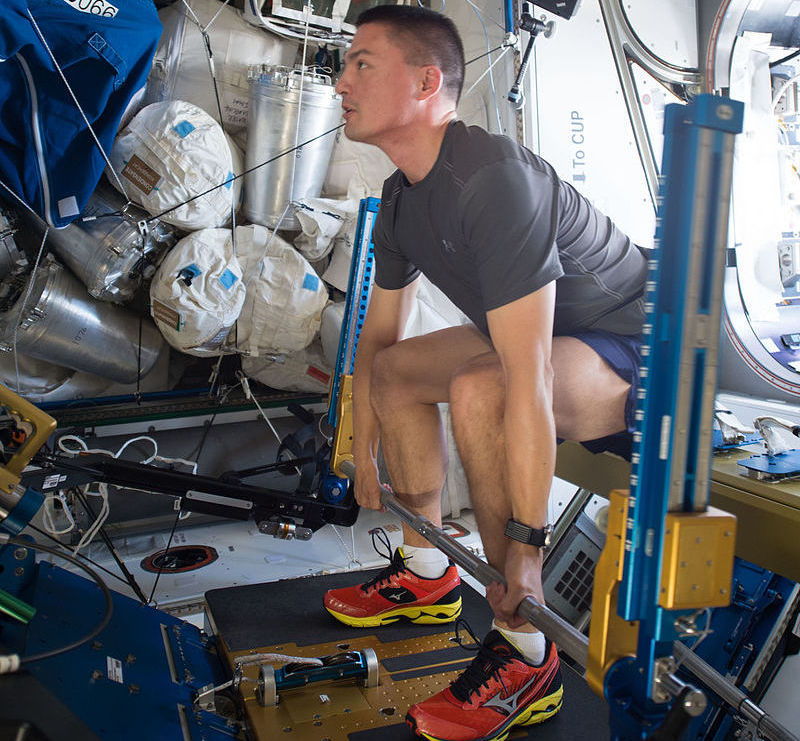
According to NASA, "research on earth and on the space station has demonstrated that high intensity resistance workouts are most effective at reducing bone and muscle loss."
In 2008, scientists at NASA developed Advanced Resistive Exercise Device (ARED) for use in space station. ARED allows astronauts to perform high intensity workouts. It can put up to 270kgs force on specific areas of the body most vulnerable to bone loss.
Another well-known practice of using high intensity mechanical stimulation for bone growth promotion is OsteoStrong (https://osteostrong.me), invented by Dr. John Jaquish.
In contrast to Dr. Rubin's low-intensity, Dr. Jaquish pushes the intensity of mechanical stimulation to the limit with his OsteoStrong devices.
Dr. Jaquish uses a linear vibration plate called GH Accelerator (similar to VT007) to enhance his X3 bar exercise, another high intensity strength exercise.
I consider OsteoStrong (https://osteostrong.me) a genius concept accomplished with a simple equipment.
Mechanical stimulation needs to achieve a certain magnitude to effectively signal bone growth.
In terms of what vibration intensity to recommend, it depends on the physical condition of each person, also depends on vibration movement pattern and exercise poses. I can reasonably believe that, for bone growth stimulation, the vibration intensity needs to satisfy the condition of inducing substantial skeletal muscle contraction.
Vibration acceleration (G-force) is not a sustained acceleration. It is in a continuous pulse pattern. The pushing force created by vibration is also in a continuous pulse pattern, each pulse last only a tiny fraction of a second. Our body better tolerates vibration G-force than sustained G-force of the same magnitude.
It is probably a good strategy to start with low intensity and gradually work up to high intensity to the extend that your body can accept. Be slow, patient, persistent and observant. VT007, with its adjustable frequency and two amplitude setting, can serve this strategy well.
Dr. Rubin stated that our body movement consists of repeated incremental muscle contractions, 20 to 50 times per second (20-50Hz). He then concluded that a very weak 30Hz vibration stimulation would act as a "surrogate" of muscle contraction to promote bone growth. Seemingly relevant, but the logic of this substitution is not clear, and Dr. Rubin did not explain.
Why Dr. Rubin wants to use a fancy "surrogate" for muscle contraction? Why not just simply use the stimulation from the muscle contraction itself to promote bone growth?
In fact, small external mechanical stimulations could hardly be transferred to the bones if not because of muscle contraction. The force would largely be absorbed by "loose" tissues before reaching to the bones.
The most effective way to transfer external mechanical stimulation to bones is through muscle contraction. When our skeletal muscles contract against an external force, the contraction transfers a pulling force of the same amount to the connecting bones.
Skeletal muscle contraction is the most effective mechanical stimulation to the connecting bones. Our bone growth mechanism is naturally designed to respond to stimulation produced by skeletal muscle contraction.
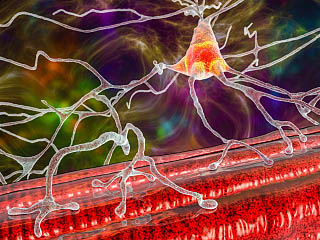
Due to our skeletal muscle's stretch reflex response, we can use vibration to induce rapidly repeated muscle contraction, which produces a dynamic pulling force on the connecting bones. Such a mechanical stimulation fits well with our natural bone growth mechanism.
Why Dr. Rubin has to come up with a "surrogate" to substitute the muscle contraction, not just simply quotes muscle contraction for the purpose?
In his videos, Dr. Rubin only touched muscle contraction briefly, then kept reiterating using vibration signal to trick our body to grow bones (no muscle work needed). He inserted a mystery by quoting "trick" through out this video to explain his theory. His "trick" concept just sounds "tricky".
Dr. Rubin said that, on his vibration plate, users should stand with their whole body straight up, in order to allow vibration signal to transmit all the way up to the head. He claimed his Marodyne does not hurt the user's knee joints with the standing straight pose.
It probably is true that his extremely low intensity Marodyne vibration plate does not impact the knee joints. In fact, with its paper-thin amplitude, Marodyne does not really impact anything, positively or negatively whatsoever.
Dr. Rubin criticized that the other manufacturers, like Power Plate and Galileo, have to advise their customers to bend their knees in order to avoid joint injury. He considers the knee bending pose a drawback because such a pose prevents vibration from transmitting to the head (to do the "trick"?).
Why we want the vibration to transmit all the way to the head? What muscles does that train? Just to "trick" our brain — another mystery. Anyway, Dr. Rubin does not think muscle exercise is necessary.
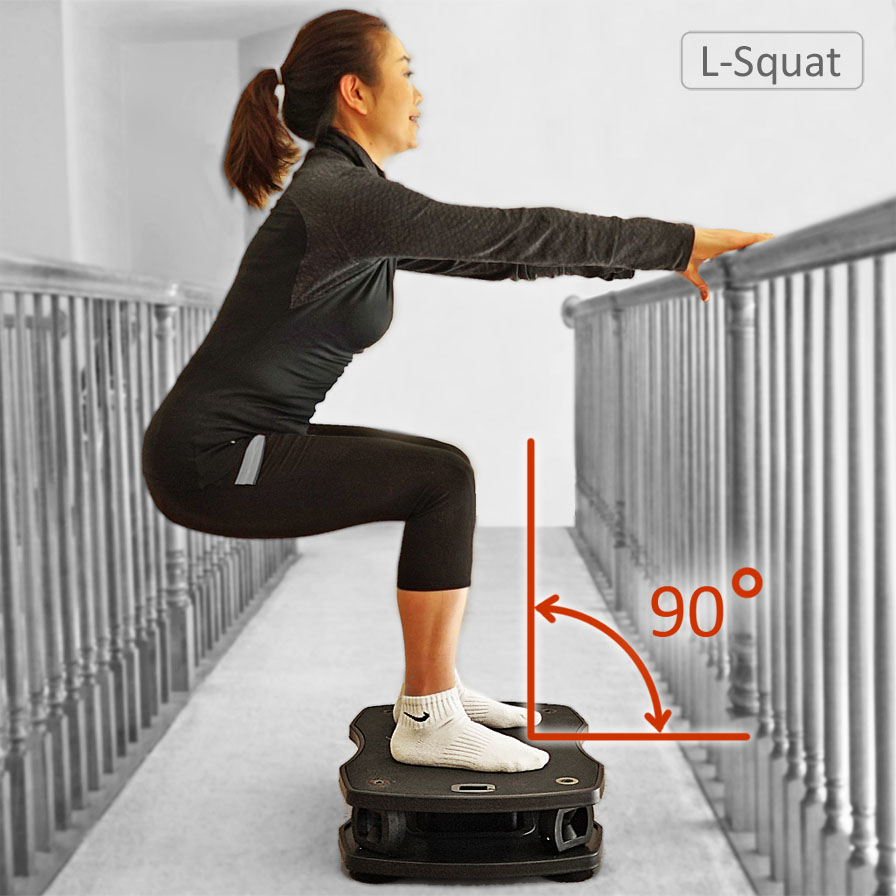
Knee bending pose, like squat, is a natural and effective way to work our lower limb muscles. It is our designed pose for flexing leg muscles, maintaining mobility and protecting our knee joints when we walk, run and jump. With knee bending, we effectively bring down the mechanical impact on our cartilages.
On a vibration plate, knee bending pose is not just for knee protection, but also essential for leg muscle exercise. Squat is the best exercise to allow vibration to induce muscle contraction around the knees and hips.
If you keep your body straight on a vibration plate, you mainly use your skeleton to resist the pull-down force. Although your muscles still contract to hold the skeleton together and maintain the balance, the workload is low. You mostly get axis-vector force pressing your bones, and your cartilages bear most pressure and impact.
If you bend you knees and allow muscles to effectively contract. The contraction produces pulling force on bones on both axis-vector and radial-vector. The radial-vector force bends the bones and produces shearing stress on the bones (stronger signal). The stimulation on bones from muscle contraction is more natural, and more effective for promoting bone growth.
Keeping knees bent in your vibration exercise, you actually introduce less physical impact to your knee cartilages than you do with walking. Also you use your muscles to resist the impact of vibration.
It is unclear if the repeated short pulses of high magnitude impact from vibration can harm the cartilage. It is a risk averse strategy to avoid impact on cartilage by bending your knees when you are on a vibration plate.
Knee bending pose also prevents the vibration from transmitting to the head. Some people get dizziness if vibration is transmitted to their heads.
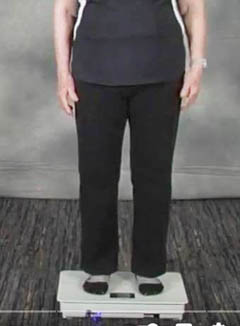
From my point of view, Marodyne, with its paper-thin amplitude, does not induce muscle contraction, and the standing straight pose does not engage much muscle work. The mechanical stimulation we need for bone growth is simply missing. I don't think Marodyne can promote bone growth.
Dr. Rubin kept saying that using Marodyne LiV is effortless. Just stand on it, casual and relax, and your bone will grow. This can be misleading.
I would never believe we can simply stand on a machine and let the machine to trick our body system to make more bone cells. We need to work our muscles and bones. There is no surrogate to muscle work, no effortless way. We don't use vibration plate to trick, but to enhance our muscle work for effectiveness and efficiency. You should use a vibration plate that actually engages your muscle work.

Dr. Rubin receives NASA funding to develop solutions for astronauts to overcome bone and muscle loss issues. He keep advertising his work with NASA but never clarify if NASA has ever endorsed or used his device.
For VT007, its designed frequency, amplitude and motion pattern can certainly induce intensive, rapidly repeated skeletal muscle contraction, which may promote bone growth with a certain level of effectiveness.
Marodyne LiV vibration plate comes with a calibration design: when a user steps on the machine, the machine will initiate by measuring the user's body weight and accordingly adjust the machine's output to insure the "0.4 G-force".
This is to state that, every person, regardless of his or her physical condition, would fit the best with the magic "0.4G". Therefore Marodyne has this calibration design to make sure the machine always provides 0.4G. This is not scientific.
Adding calibration function looks like a pseudoscience approach: trying to make this thing to sound like a fancy technology.
Marodyne is already a very low intensity vibration, why it has to be the exact 0.4G. Let alone it is a wrong calculation. Plus, Marodyne has a fluctuating amplitude, contradictory to a fixed G-force.
From engineering perspective, this calibration design has a fake logic. I have reasons to believe that for such a machine, the combined error of its analog components, circuits, sensor and actuator has already brought in an amplitude deviation that outweighs the amplitude fluctuation due to different body weight. It makes no sense to add a calibration design. Marodyne may use a feedback loop to solve the error issue, but I don't think the distance sensor is accurate enough to validate such a design.
This calibration design is fake.

Scientific studies on vibration therapy for osteoporosis are very limited.
Most research projects are literature reviews. Research are mostly conducted in universities with very limited resource (funding). Check www.pubmed.gov for citations and papers of research trials on vibration therapy applications for bone loss.
All of these research trials are conducted in small sample size, not adequately designed and implemented, often unfinished. None of the studies has led to a reliable conclusion for any applicable modality and efficacy.
There are too many variables to test for a certain modality. A research trial may fail to produce a positive result because of a wrongly selected parameter, such as movement pattern, exercise pose, frequency, amplitude and time (dosage). It would be very time consuming and would require many repetitive trial processes to test multiple variables and their combinations. However scientists lack funding or commercial incentive to conduct such a costly research trial.
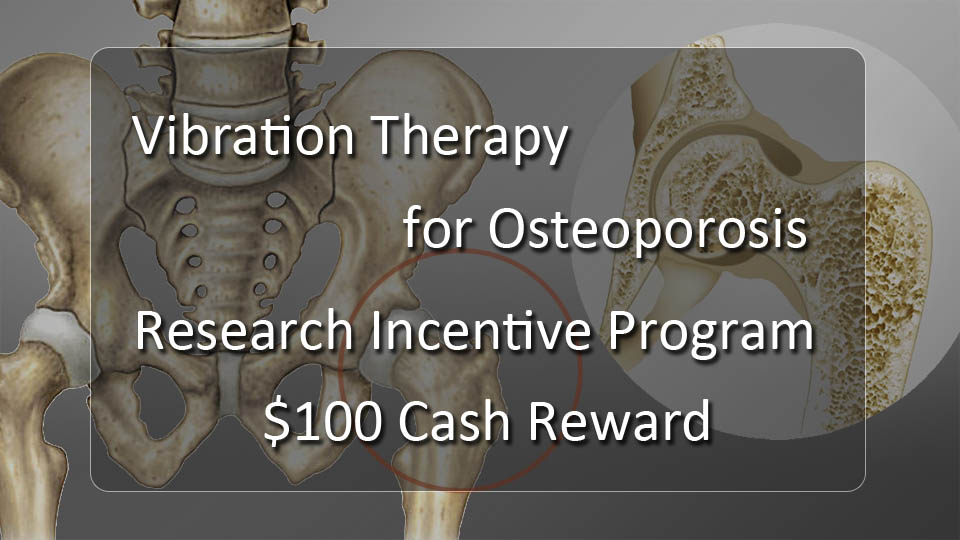
Vibration Therapeutic® LLC offers a research incentive program for the study of using vibration therapy to treat osteoporosis.
Each participant will get $100 cash reward. Click here for the program details ↝
Work your muscles for bone health, using a vibration plate to enhance the effectiveness.
Thanks for viewing. Please leave your comments below.
Interpreting life science from an engineering perspective.
Featured Posts: